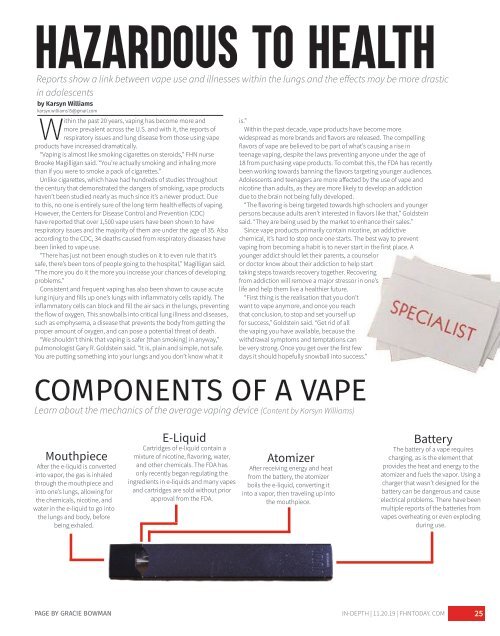Create successful ePaper yourself
Turn your PDF publications into a flip-book with our unique Google optimized e-Paper software.
Hazardous to health<br />
Reports show a link between vape use and illnesses within the lungs and the effects may be more drastic<br />
in adolescents<br />
by Karsyn Williams<br />
karsyn.williams15@gmail.com<br />
Within the past 20 years, vaping has become more and<br />
more prevalent across the U.S. and with it, the reports of<br />
respiratory issues and lung disease from those using vape<br />
products have increased dramatically.<br />
“Vaping is almost like smoking cigarettes on steroids,” FHN nurse<br />
Brooke Magilligan said. “You’re actually smoking and inhaling more<br />
than if you were to smoke a pack of cigarettes.”<br />
Unlike cigarettes, which have had hundreds of studies throughout<br />
the century that demonstrated the dangers of smoking, vape products<br />
haven’t been studied nearly as much since it’s a newer product. Due<br />
to this, no one is entirely sure of the long term health effects of vaping.<br />
However, the Centers for Disease Control and Prevention (CDC)<br />
have reported that over 1,500 vape users have been shown to have<br />
respiratory issues and the majority of them are under the age of 35. Also<br />
according to the CDC, 34 deaths caused from respiratory diseases have<br />
been linked to vape use.<br />
“There has just not been enough studies on it to even rule that it’s<br />
safe, there’s been tons of people going to the hospital,” Magilligan said.<br />
“The more you do it the more you increase your chances of developing<br />
problems.”<br />
Consistent and frequent vaping has also been shown to cause acute<br />
lung injury and fills up one’s lungs with inflammatory cells rapidly. The<br />
inflammatory cells can block and fill the air sacs in the lungs, preventing<br />
the flow of oxygen. This snowballs into critical lung illness and diseases,<br />
such as emphysema, a disease that prevents the body from getting the<br />
proper amount of oxygen, and can pose a potential threat of death.<br />
“We shouldn’t think that vaping is safer [than smoking] in anyway,”<br />
pulmonologist Gary R. Goldstein said. “It is, plain and simple, not safe.<br />
You are putting something into your lungs and you don’t know what it<br />
is.”<br />
Within the past decade, vape products have become more<br />
widespread as more brands and flavors are released. The compelling<br />
flavors of vape are believed to be part of what’s causing a rise in<br />
teenage vaping, despite the laws preventing anyone under the age of<br />
18 from purchasing vape products. To combat this, the FDA has recently<br />
been working towards banning the flavors targeting younger audiences.<br />
Adolescents and teenagers are more affected by the use of vape and<br />
nicotine than adults, as they are more likely to develop an addiction<br />
due to the brain not being fully developed.<br />
“The flavoring is being targeted towards high schoolers and younger<br />
persons because adults aren’t interested in flavors like that,” Goldstein<br />
said. “They are being used by the market to enhance their sales.”<br />
Since vape products primarily contain nicotine, an addictive<br />
chemical, it’s hard to stop once one starts. The best way to prevent<br />
vaping from becoming a habit is to never start in the first place. A<br />
younger addict should let their parents, a counselor<br />
or doctor know about their addiction to help start<br />
taking steps towards recovery together. Recovering<br />
from addiction will remove a major stressor in one’s<br />
life and help them live a healthier future.<br />
“First thing is the realisation that you don’t<br />
want to vape anymore, and once you reach<br />
that conclusion, to stop and set yourself up<br />
for success,” Goldstein said. “Get rid of all<br />
the vaping you have available, because the<br />
withdrawal symptoms and temptations can<br />
be very strong. Once you get over the first few<br />
days it should hopefully snowball into success.”<br />
COMPONENTS OF A VAPE<br />
Learn about the mechanics of the average vaping device (Content by Karsyn Williams)<br />
Mouthpiece<br />
After the e-liquid is converted<br />
into vapor, the gas is inhaled<br />
through the mouthpiece and<br />
into one’s lungs, allowing for<br />
the chemicals, nicotine, and<br />
water in the e-liquid to go into<br />
the lungs and body, before<br />
being exhaled.<br />
E-Liquid<br />
Cartridges of e-liquid contain a<br />
mixture of nicotine, flavoring, water,<br />
and other chemicals. The FDA has<br />
only recently began regulating the<br />
ingredients in e-liquids and many vapes<br />
and cartridges are sold without prior<br />
approval from the FDA.<br />
Atomizer<br />
After receiving energy and heat<br />
from the battery, the atomizer<br />
boils the e-liquid, converting it<br />
into a vapor, then traveling up into<br />
the mouthpiece.<br />
Battery<br />
The battery of a vape requires<br />
charging, as is the element that<br />
provides the heat and energy to the<br />
atomizer and fuels the vapor. Using a<br />
charger that wasn’t designed for the<br />
battery can be dangerous and cause<br />
electrical problems. There have been<br />
multiple reports of the batteries from<br />
vapes overheating or even exploding<br />
during use.<br />
PAGE BY GRACIE BOWMAN<br />
IN-DEPTH | 11.20.19 | FHNTODAY. COM<br />
25





